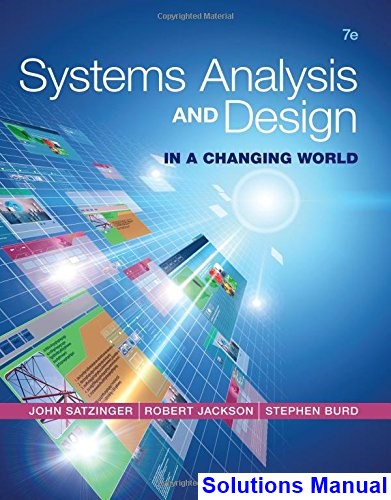Systems Analysis and Design in a Changing World 7th Edition Satzinger Solutions Manual

Product details:
- ISBN-10 : 1305117204
- ISBN-13 : 978-1305117204
- Author: John Satzinger
Reflecting the latest practices, trends, and developments from the field, SYSTEMS ANALYSIS AND DESIGN IN A CHANGING WORLD, 7E equips you with a solid foundation of the most important principles of systems analysis, systems design, project management, and new software development approaches. Using case driven techniques, the succinct 14-chapter book focuses on content that is key to your success in today’s market. The book teaches both traditional (structured) and object-oriented (OO) approaches to systems analysis and design. It highlights use cases, use diagrams, and use case descriptions required for a modeling approach, while demonstrating their application to traditional, web development, object-oriented, and service-oriented architecture approaches. Content reflects Microsoft Project 2013 Professional and Microsoft Visio 2013.
Table contents:
- Part One: Introduction to System Development
- Ch One: From Beginning to End: An Overview of Systems Analysis and Design
- Ch One: Chapter Outline
- Ch One: Learning Objectives
- Software Development and Systems Analysis and Design
- The System Development Life Cycle (SDLC)
- Iterative Development
- Introduction to Ridgeline Mountain Outfitters (RMO)
- Developing RMO’s Tradeshow System
- Where You Are Headed—The Rest of This Book
- Ch One: Chapter Summary
- Ch One: Key Terms
- Ch One: Review Questions
- Ch One: Problem and Exercises
- Ch One: Chapter Case
- Part Two: Systems Analysis Activities
- Ch Two: Investigating System Requirements
- Ch Two: Chapter Outline
- Ch Two: Learning Objectives
- Ch Two: Overview
- The RMO Consolidated Sales and Marketing System Project
- Systems Analysis Activities
- What Are Requirements?
- Stakeholders
- Information-Gathering Techniques
- Models and Modeling
- Documenting Workflows with Activity Diagrams
- Ch Two: Chapter Summary
- Ch Two: Key Terms
- Ch Two: Review Questions
- Ch Two: Problems and Exercises
- Ch Two: Case Study
- Ch Two: Running Case Studies
- Ch Two: Further Resources
- Ch Three: Identifying User Stories and Use Cases
- Ch Three: Chapter Outline
- Ch Three: Learning Objectives
- Ch Three: Overview
- User Stories and Use Cases
- Use Cases and the User Goal Technique
- Use Cases and Event Decomposition
- Use Cases in the Ridgeline Mountain Outfitters Case
- Ch Three: Chapter Summary
- Ch Three: Key Terms
- Ch Three: Review Questions
- Ch Three: Problems and Exercises
- Ch Three: Case Study
- Ch Three: Running Case Studies
- Ch Three: Further Resources
- Ch Four: Domain Modeling
- Ch Four: Chapter Outline
- Ch Four: Learning Objectives
- Ch Four: Overview
- “Things” in the Problem Domain
- The Entity-Relationship Diagram
- The Domain Model Class Diagram
- The State Machine Diagram—Identifying Object Behavior
- Ch Four: Chapter Summary
- Ch Four: Key Terms
- Ch Four: Review Questions
- Ch Four: Problems and Exercises
- Ch Four: Case Study
- Ch Four: Running Case Studies
- Ch Four: Further Resources
- Ch Five: Use Case Modeling
- Ch Five: Chapter Outline
- Ch Five: Learning Objectives
- Ch Five: Overview
- Use Case Descriptions
- Activity Diagrams for Use Cases
- The System Sequence Diagram—Identifying Inputs and Outputs
- SSD Notation
- Use Cases and CRUD
- Integrating Requirements Models
- Ch Five: Chapter Summary
- Ch Five: Key Terms
- Ch Five: Review Questions
- Ch Five: Problems and Exercises
- Ch Five: Case Study
- Ch Five: Running Case Studies
- Ch Five: Further Resources
- Part Three: Essentials of Systems Design
- Ch Six: Foundations for Systems Design
- Ch Six: Chapter Outline
- Ch Six: Learning Objectives
- Ch Six: Overview
- What Is Systems Design?
- Design Activities
- System Controls and Security
- Ch Six: Chapter Summary
- Ch Six: Key Terms
- Ch Six: Review Questions
- Ch Six: Problems and Exercises
- Ch Six: Case Study
- Ch Six: Running Case Studies
- Ch Six: Further Resources
- Ch Seven: Defining the System Architecture
- Ch Seven: Chapter Outline
- Ch Seven: Learning Objectives
- Ch Seven: Overview
- Anatomy of a Modern System
- Architectural Concepts
- Interoperability
- Architectural Diagrams
- Describing the Environment
- Designing Application Components
- Ch Seven: Chapter Summary
- Ch Seven: Key Terms
- Ch Seven: Review Questions
- Ch Seven: Problems and Exercises
- Ch Seven: Case Study
- Ch Seven: Running Case Studies
- Ch Seven: Further Resources
- Ch Eight: Designing the User Interface
- Ch Eight: Chapter Outline
- Ch Eight: Learning Objectives
- Ch Eight: Overview
- Understanding the User Experience and the User Interface
- Fundamental Principles of User-Interface Design
- Transitioning from Analysis to User-Interface Design
- User-Interface Design
- Designing Reports, Statements, and Turnaround Documents
- Ch Eight: Chapter Summary
- Ch Eight: Key Terms
- Ch Eight: Review Questions
- Ch Eight: Problems and Exercises
- Ch Eight: Case Study
- Ch Eight: Running Case Studies
- Ch Eight: Further Resources
- Ch Nine: Designing the Database
- Ch Nine: Chapter Outline
- Ch Nine: Learning Objectives
- Ch Nine: Overview
- Databases and Database Management Systems
- Database Design and Administration
- Relational Databases
- Distributed Database Architectures
- Protecting the Database
- Ch Nine: Chapter Summary
- Ch Nine: Key Terms
- Ch Nine: Review Questions
- Ch Nine: Problems and Exercises
- Ch Nine: Case Study
- Ch Nine: Running Case Studies
- Ch Nine: Further Resources
- Part Four: System Development and Project Management
- Ch Ten: Approaches to System Development
- Ch Ten: Chapter Outline
- Ch Ten: Learning Objectives
- Ch Ten: Overview
- The System Development Life Cycle
- Methodologies, Models, Tools, and Techniques
- Agile Development
- The Unified Process, Extreme Programming, and Scrum
- Ch Ten: Chapter Summary
- Ch Ten: Key Terms
- Ch Ten: Review Questions
- Ch Ten: Problems and Exercises
- Ch Ten: Case Study
- Ch Ten: Running Case Studies
- Ch Ten: Further Resources
- Ch Eleven: Project Planning and Project Management
- Ch Eleven: Chapter Outline
- Ch Eleven: Learning Objectives
- Ch Eleven: Overview
- Principles of Project Management
- Activities of Core Process 1: Identify the Problem and Obtain Approval
- Activities of Core Process 2: Plan and Monitor the Project
- Ch Eleven: Chapter Summary
- Ch Eleven: Key Terms
- Ch Eleven: Review Questions
- Ch Eleven: Problems and Exercises
- Ch Eleven: Case Study
- Ch Eleven: Running Case Studies
- Ch Eleven: Further Resources
- Part Five: Advanced Design and Deployment Concepts
- Ch Twelve: Object-Oriented Design: Fundamentals
- Ch Twelve: Chapter Outline
- Ch Twelve: Learning Objectives
- Ch Twelve: Overview
- Object-Oriented Design: Bridging from Analysis to Implementation
- Steps of Object-Oriented Design
- Design Classes and the Design Class Diagram
- Designing with CRC Cards
- Fundamental Principles for Good Design
- Ch Twelve: Chapter Summary
- Ch Twelve: Key Terms
- Ch Twelve: Review Questions
- Ch Twelve: Problems and Exercises
- Ch Twelve: Case Study
- Ch Twelve: Running Case Studies
- Ch Twelve: Further Resources
- Ch Thirteen: Object-Oriented Design: Use Case Realization
- Ch Thirteen: Chapter Outline
- Ch Thirteen: Learning Objectives
- Ch Thirteen: Overview
- Object-Oriented Design with Interaction Diagrams
- Use Case Realization with Communication Diagrams
- Use Case Realization with Sequence Diagrams
- Developing a Multilayer Design
- Updating and Packaging the Design Classes
- Design Patterns
- Ch Thirteen: Chapter Summary
- Ch Thirteen: Key Terms
- Ch Thirteen: Review Questions
- Ch Thirteen: Problems and Exercises
- Ch Thirteen: Case Study
- Ch Thirteen: Running Case Studies
- Ch Thirteen: Further Resources
- Ch Fourteen: Deploying the New System
- Ch Fourteen: Chapter Outline
- Ch Fourteen: Learning Objectives
- Ch Fourteen: Overview
- Testing
- Deployment Activities
- Managing Implementation, Testing, and Deployment
- Putting It All Together—RMO Revisited
- Ch Fourteen: Chapter Summary
- Ch Fourteen: Key Terms
- Ch Fourteen: Review Questions
- Ch Fourteen: Problems and Exercises
- Ch Fourteen: Case Study
- Ch Fourteen: Running Case Studies
- Ch Fourteen: Further Resources
- Index
People also search:
systems analysis and design in a changing world 8th edition
systems analysis and design in a changing world 7th edition
systems analysis and design in a changing world ebook
systems analysis and design in a changing world 6th edition
windows 7 system reset to factory





